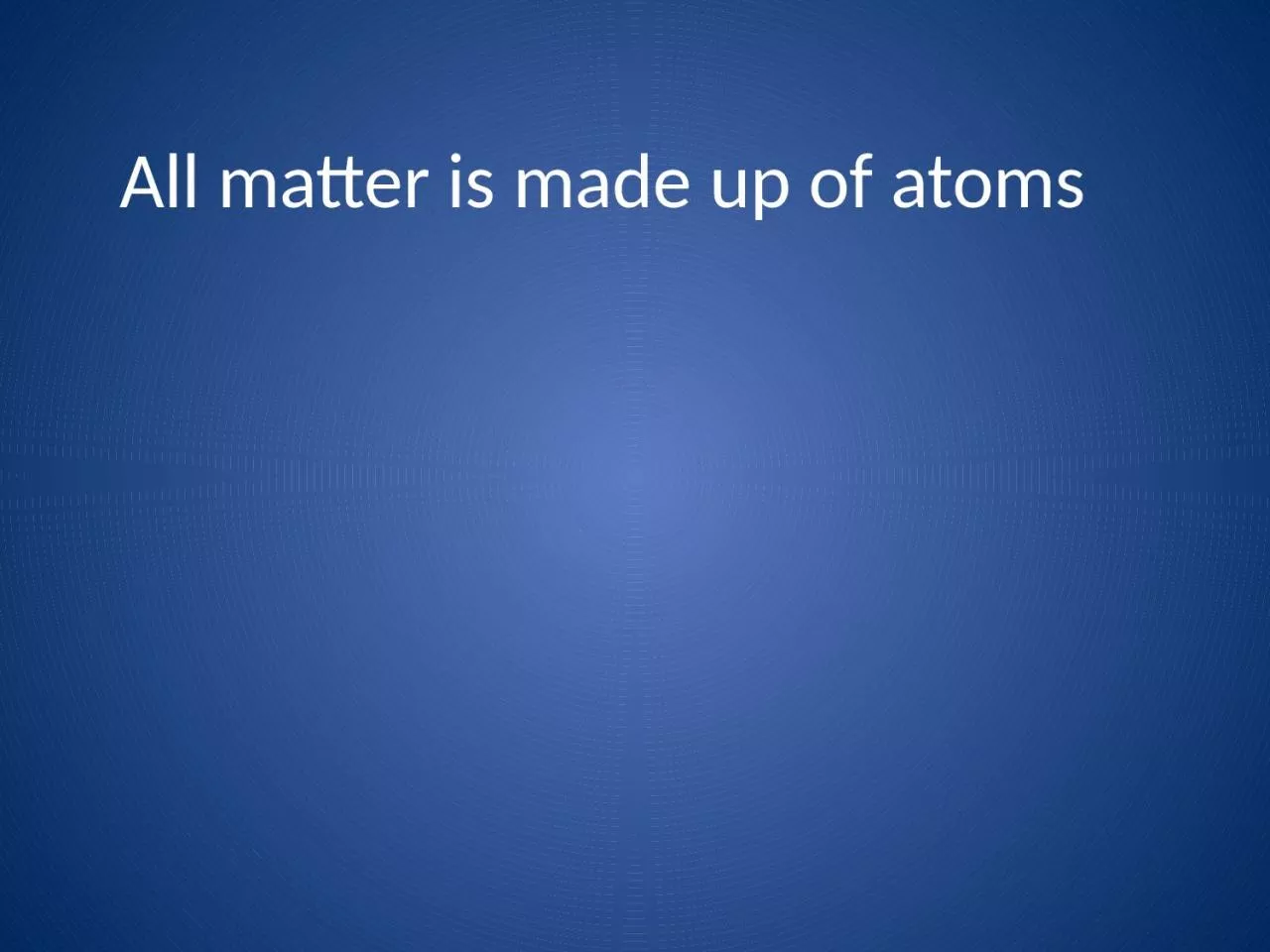

Atoms have two parts Atomic structure Nucleus Electron cloud The nucleus is made up of two atomic sub particles The nucleus is made up of two atomic sub particles Nucleus ID: 915140
Download Presentation The PPT/PDF document "All matter is made up of atoms" is the property of its rightful owner. Permission is granted to download and print the materials on this web site for personal, non-commercial use only, and to display it on your personal computer provided you do not modify the materials and that you retain all copyright notices contained in the materials. By downloading content from our website, you accept the terms of this agreement.
Slide1
All matter is made up of atoms
Slide2Atoms have two parts
Slide3Atomic structure
Nucleus Electron cloud
Slide4The nucleus is made up of two atomic sub particles.
Slide5The nucleus is made up of two atomic sub particles.
Nucleus
a positively (+)
charged
P
roton
+
+
+
+
Slide6The nucleus is made up of two atomic sub particles.
Nucleus
a positively (+) a particle with NO
charged charge (0) called a
Proton Neutron.
+
+
+
+
0
0
0
0
Slide7The
electron cloud
is made up of
one atomic sub particle.
Slide8The
electron cloud
is made up of
one atomic sub particle.
a negatively (-) charged Electron
+
+
+
+
0
0
0
0
-
-
-
-
Slide9This is a Bohr model of the Beryllium atom.
+
+
+
+
0
0
0
0
-
-
-
-
0
Slide10This atom has a charge that is in equilibrium. 4 positive charges balance out the
4
negatively charged electrons.
The neutrons carry NO charge and therefor have no effect on the charge of the atom
.
+
+
+
+
0
0
0
0
-
-
-
-
Slide11Atoms lose their protons or neutrons but it is extremely difficult and time consuming. They can lose their electrons very easily.
+
+
+
+
0
0
0
0
-
-
-
-
0
Slide12If this Beryllium atom losses an electron it would become positively charged.
+
+
+
+
0
0
0
0
-
-
-
Because there are more positively charged
protons than negative charges.
0
Slide13If this Beryllium atom loses an electron it would become positively charged.
+
+
+
+
0
0
0
0
-
-
-
Because there are more positively charged
protons than negative charges.
It is no longer
called an atom.
It is called an
ion.
Specifically
a
cation
.
Slide14If this Beryllium atom gains an electron it would become negatively charged.
+
+
+
+
0
0
0
0
-
-
-
Because there are more negatively charged
protons than positively charged protons.
It is no longer
called an atom.
It is called an
ion.
-
-
Specifically an anion.
Slide15Using the periodic table to create a Bohr Model of an atom.
The periods (rows)
Indicate the number of
Orbitals (energy shells or
e
lectron shells)
t
hat make up the
electron
cloud.
Slide16Using the periodic table to create a Bohr Model of an atom.
Columns (called groups or families) indicate the number of electrons
t
hat can be found in the outermost energy shell
called the valence
Shell.
Slide17How many energy shells does Potassium (K) have?
.
Slide18How many valence electrons (electrons in the outer shell) does Potassium (K) have?
.
Slide19Each square of the periodic table gives particular information about the atoms of an element. Txt. P. 19
The atomic number tells you
How many protons and
Electrons the element has.
The Chemical symbol of
The element.
The atomic mass made
up of protons and
Neutrons.
Subtracting the atomic number from the mass, will give us the number of neutrons in the element
Slide20Electron configuration rules
1. The innermost shell, due to its radius, can only hold 2 electrons.
2. The next shell can hold 8 electrons.
3. The third shell can hold up to 18 electrons.
4. The 4
th
shell can hold up to 32 electrons.
Slide21With these rules in mind create a Bohr model of Al.
.
Slide22Al is in the 3
rd
period and 13
th
group.
As a result, we know that AL has __
electron shells and___electrons in its valence shell. Its atomic number is_____a
nd so
has___protons
and___ electrons.
Its atomic mass is___ and so it has _____
n
eutrons.
Slide23Slide24-
3
rd
period= 3 energy shells
-
-
13
th
family= 3 valence electrons
Slide25-
Rule 1: there are 2 electrons
In the inner shell.
-
-
-
-
Slide26-
Atomic number is 13. So it
Has 13 electrons all together.
-
-
-
-
So how many electrons will there be in
the shell that we haven’t filled yet?
Slide27-
-
-
-
-
-
-
-
-
-
-
-
-
Slide28-
-
-
-
-
-
-
-
-
-
-
-
-
13P
14N
13P
13.982N